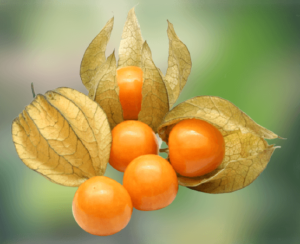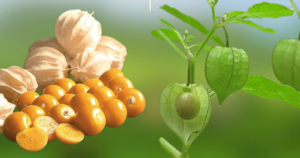Ground cherry or Husk Cherries or Husk Tomato
Overview:
Ground cherry’s Scientific name: Physalis angulata
Ground cherry is a species of flowering plant in the nightshade family (Solanaceae).
Peruvian Ground cherry originates in Peru. This crop has been cultivated in many parts of the world since the 18th century.
Currently cultivated worldwide. It is widely cultivated in India. The fruit is small, yellow to orange and similar to small tomato in size, shape and structure.
The fruit can be used like a tomato. It can be eaten raw and used in salads. Some varieties are added as a sweetener to taste. It is used as a dried raisin to preserve the fruit.
Propagation is by Ground cherry seeds.
The fruit is surrounded by the paper husk. Looks like a small orange, but tastes uniquely sweet: a mixture of pineapple, strawberry and green grapes. Ground Cherry is available all year round but peak season is towards the end of summer.
Commonly they are called Cape Gooseberry, Strawberry tomato, Goldenberry and Physalis. Known in Europe as the “ground cherry”.
Commonly More different names are called ,such as Annual ground cherry, Angular winter cherry, Balloon cherry, Bladder cherry, Bladder berry, Bolsa mulaca, lance-leaf ground cherry , Cow pops, Cut-leaved ground cherry, Cutleaf groundcherry, Dog tomato, Fisalia, Fisalia tooth-leaved bladder, Hog weed, Husk Tomato, Mullaca, Sun berry, Tooth-leaved winter cherry, Wild cape gooseberry, Wild physalis, Wild tomato, Winter cherry, Bush tomato, Chinese lantern, goose berry , Indian gooseberry weed, Mullaca, Native gooseberry, Battre autour, Bolsa mullaca, Camapu, Husk Cherries.
Nutrition
Ground Cherries nutrition value per 100 gm:
Water: 85 gm
Protin: 2 gm
Carbohydrate: 11 gm
Total Fat : 0.7 gm
Cholesterol: 0 gm
Calcium : 9 mg
Iron: 1 mg
Phosphorus: 40 mg
Vitamin-C: 11 mg
Thiamin: 0.110 mg
Riboflavin: 0.04 mg
Niacin: 2.8 mg
Health benefits
1. Prevention of heart disease
Vitamin C is good protection for your body because it helps keep you away from free-radical cells which can damage the blood vessels. This type of heart disease is one of the leading causes of serious illness.
This tiny fruit is not only good for heart disease but also keeps for other cardiovascular problems. It lowers blood pressure and keeps LDL low while raising HDL.
2. Low cholesterol
High levels of cholesterol have been linked to a number of serious illnesses, such as stroke. A mixture of vitamin C and vitamin A ground cherries can keep the body’s cholesterol low.
3. Maintaining bone density
Another effect of oxidative stress from free radicals is loss of bone density, especially in women. Eating vitamin C helps you maintain bone density so you can stay healthy.
4. Prevent scurvy
Scurvy is a condition where your body is deficient in vitamin C, which leads to weakness. Symptoms include curly hair, body aches, and fatigue. This condition can be improved by eating regular vitamin C rich fruits for a certain period of time to get your body back to health.
5. Cancer prevention:
Ground cherries have many health benefits. It has been shown in research that eating foods rich in vitamin-C is associated with the treatment of cancers including lung cancer, stomach cancer, colon cancer and oral cancer.
6. Vision improvement:
Eating ground cherries helps to replenish your daily vitamin A. Vitamin A’s ability to improve eyesight includes preventing blindness and dry eyes because it helps your eyes adapt better to dark and light.
Moreover, it helps to keep the retina healthy which in turn prevents cataracts. Combined with vitamin C, this vitamin can provide even better protection from cataracts.
7. Treatment of diabetes:
Vitamin C is quite helpful in the treatment of diabetes because it stimulates the processing of glucose and insulin. This is why studies have shown a link between vitamin C deficiency and diabetes.
8. Preventing urine stones:
Vitamin A forms calcium phosphate which contributes to the prevention of bladder stones. By keeping the lining of the urethra in its shape, the vitamin A in the cut leaf ground cherries reduces the risk of stone formation in the urethra.
Ground cherry toxicity
Immature ground cherry is very sour. It contains solanine and solanidine which are toxic compounds that can cause small amounts of nausea, diarrhea and stomach cramps. Eating moderate to high amounts can be dangerous. All parts of the ground cherry plant except the ripe fruit are poisonous.
How to growing Ground cherry

You can start your ground cherry cultivation from seeds indoors. Ground cherry plants are well fertilized in organic matter rich, moist and rich in drainage soils.
Place the ground cherry seeds on top of the soil and then lightly cover with a thin layer of soil, about 1/4 inch. Gently press the soil.
Water the seeds after planting, and then continue to spray gently every day until the seeds germinate. The seeds germinate in about five to eight days. Ground cherry plants are about 30-50 cm tall.
The flowers are born 5-40mm long from June to October. After fertile flowering, an orange ovary berry emerges which is 1-1.8 cm long and surrounded on the outer layer. This outer layer is 2-6 mm long, it grows around and surrounds the fruit.
The calyx of the fruit is pale green (pale brown when dry), bulging, 10-angled or ribbed, 23-35 mm long and 15-25 mm wide. It is carried on a stalk 1-4 cm long. Seeds disc-shaped 1-2 mm long, flat, pale yellow. The fruit is very tasty in taste.
Preserving ground cherry
This ground cherry is a lot of antioxidants and a great source of vitamins A and C, but also contains vitamins B-1, B-2 and B-3. Consider crop conservation for higher yields. Before storing, remove the bran and wash the berries thoroughly. Can be stored through a jam, dehydrating, frozen or fermented.
References: